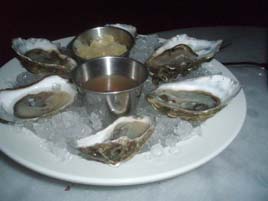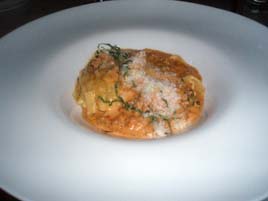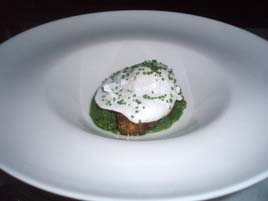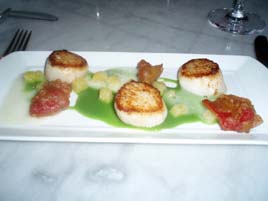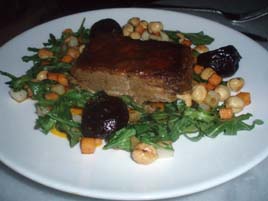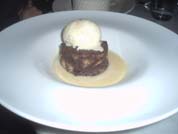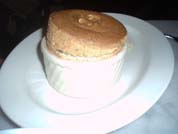La Petite Maison
 Tuesday, March 29, 2011 at 12:53PM
Tuesday, March 29, 2011 at 12:53PM Note: La Petite Maison closed in July 2012 after a brief, undistinguished run.
 Did you ever get the sense that Sam Sifton, the New York Times critic, doesn’t like food? Perhaps that would explain why his columns waste anywhere from a third to half the space reviewing the guests, rather than the restaurant.
Did you ever get the sense that Sam Sifton, the New York Times critic, doesn’t like food? Perhaps that would explain why his columns waste anywhere from a third to half the space reviewing the guests, rather than the restaurant.
This was the case last week, when he awarded one star to La Petite Maison, the import from Nice that opened recently in the old townhouse (formerly owned by the Rockefellers) that was once home to Aquavit and Grayz.
 The photo on the left headlined the review, suggesting that La Petite Maison is a big party that just happens to serve food. Perhaps that’s the case some evenings, but not last Thursday. Instead, we found a normal adult restaurant, doing brisk business, not unlike many successful places that get the benefit of a fair review without such a misleading photo.
The photo on the left headlined the review, suggesting that La Petite Maison is a big party that just happens to serve food. Perhaps that’s the case some evenings, but not last Thursday. Instead, we found a normal adult restaurant, doing brisk business, not unlike many successful places that get the benefit of a fair review without such a misleading photo.
Admittedly, the name’s a bit of a dodge. The bi-level house isn’t petite at all. It’s loud when full, and the tables are so tightly packed that you’ll need the agility of a belly dancer to make your way across the room. We had probably the best table in the house, a four-top in the corner, set for a couple: at least the sound came at us from two directions, rather than four.
The old Grayz décor, which will be missed by no one, was jettisoned in favor of a bright, modern-looking room with handsome, Warholesque artwork on the walls, and crisp, white tablecloths. It’s not for twentysomethings. Downtowners will despise the obvious midtown vibe, but it’s nice to see a new place that’s not a clone of ten others you’ve been to.
It is a clone of one particular place, La Petite Maison in Nice. Alain Allegretti, of the eponymous (and sadly closed) Allegretti, was brought in as consulting chef. The nature or duration of his duties is unclear, but the menu has very little of his influence. It’s mostly a carbon copy of what they serve at the mother ship. (A Provençal soup seems to be his main contribution.)
Sticker shock may be the initial reaction, with appetizers $9–22 and entrées $24–45. If you’re getting tired of the recent trend of “entrées for two,” you may be irritated that five out of fifteen entrées are in that format. There is also a separate section dedicated to truffles, wherein you can indulge your taste for truffled eggs ($45), truffled macaroni ($55), or a truffle sandwich ($85). Roasted shrimp at $42 may seem inexplicable, but you can also dine quite economically on Cesar [sic] salad for $13, or black tagliolini with shrimp and sea urchin for $24.
Indeed, more of the items are sensibly priced than not, when adjusted for midtown rents. Salade Niçoise ($15) and Zucchini Blossom Beignets ($15) were good recreations of familiar classics. Chateaubriand for two ($70) was arguably a bargain: it’s slightly better, but much more expensive at Keens ($106), and these days there aren’t many places that serve this old favorite at all. And Keens doesn’t include the wonderful side dish of mashed potatoes, which was as soft and creamy as any you’ll find.
We experienced none of the obnoxious upselling that Sam Sifton complained about. Nevertheless, there were some odd service lapses. Baguettes (very good) came in a paper bag, without butter or bread plates. The chateaubriand came with two sauces (unnanounced), which I took to be the traditional au poivre and Bearnaise. But they came in water glasses, without serving spoons: most odd. And for $70, you’d think they could actually serve the steak, rather than just dropping a skillet into the center of the table. Our server disappeared for long intervals. Apparently, they didn’t mind that we occupied our table for almost three hours.
The menu is a bit cheap-looking, and is written in slightly awkward English, but the receipt is in French. I have to assume that they intended to use French all along, and chickened out at the last minute. This strikes me as a misjudgment: those who patronize French restaurants usually want the real thing. Some diners might not know that courgette means zucchini (that’s what translations are for), but is Salade Niçoise so intimidating that it needs to be replaced with “Traditional salad of Nice”?
These may seem like small points, but this is, after all, a French restaurant, where dinner for two will exceed $100 a head, assuming you don’t drink water. The wine list isn’t long, but if it’s short on bargains, it’s well worth exploring. How many restaurants offer a 1998 Château Vannières, much less at $85?
La Petite Maison could do a better job of embracing and celebrating its Niçoise heritage. In a month or two, the party revelers that Sifton complained about will have moved on to the Next Big Thing, and we’ll be left with a comfortable, upscale French restaurant for midtown adults.
La Petite Maison (13–15 W. 54th Street between Fifth & Sixth Avenues, West Midtown)
Food: *
Service: *
Ambiance: **
Overall: *














